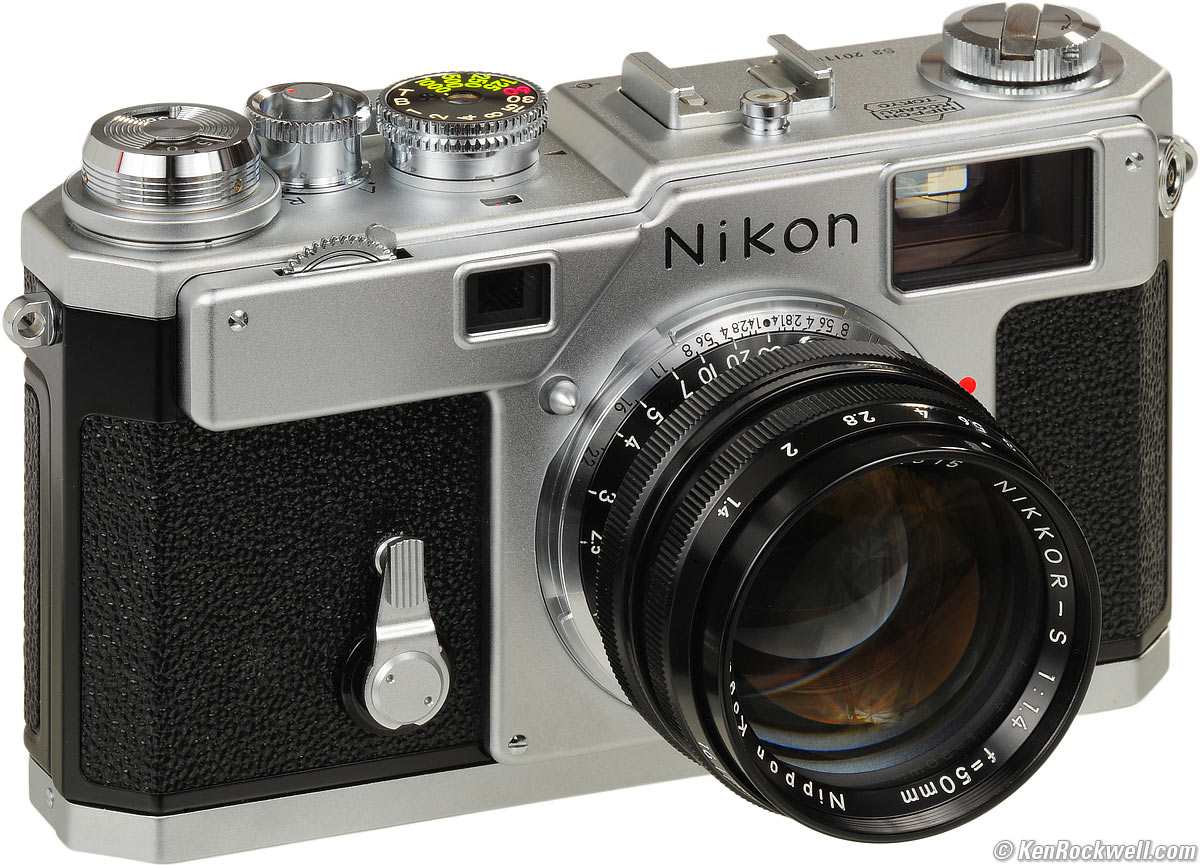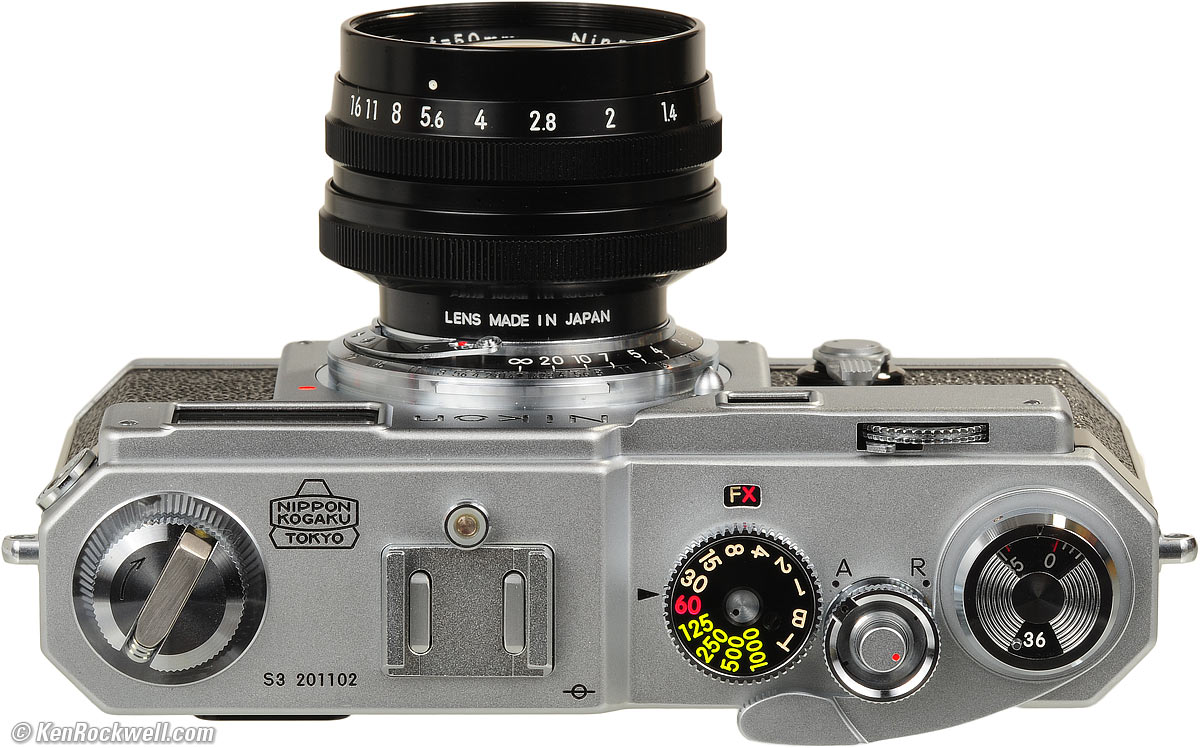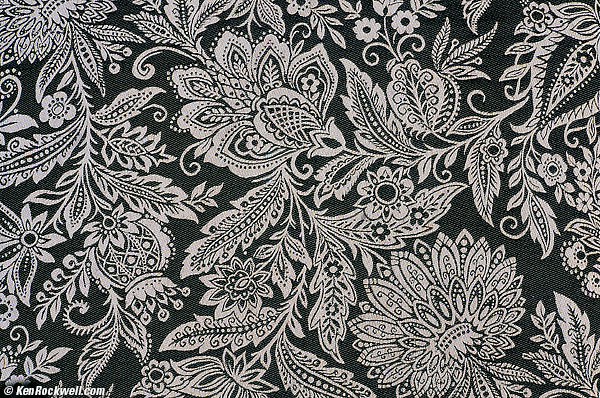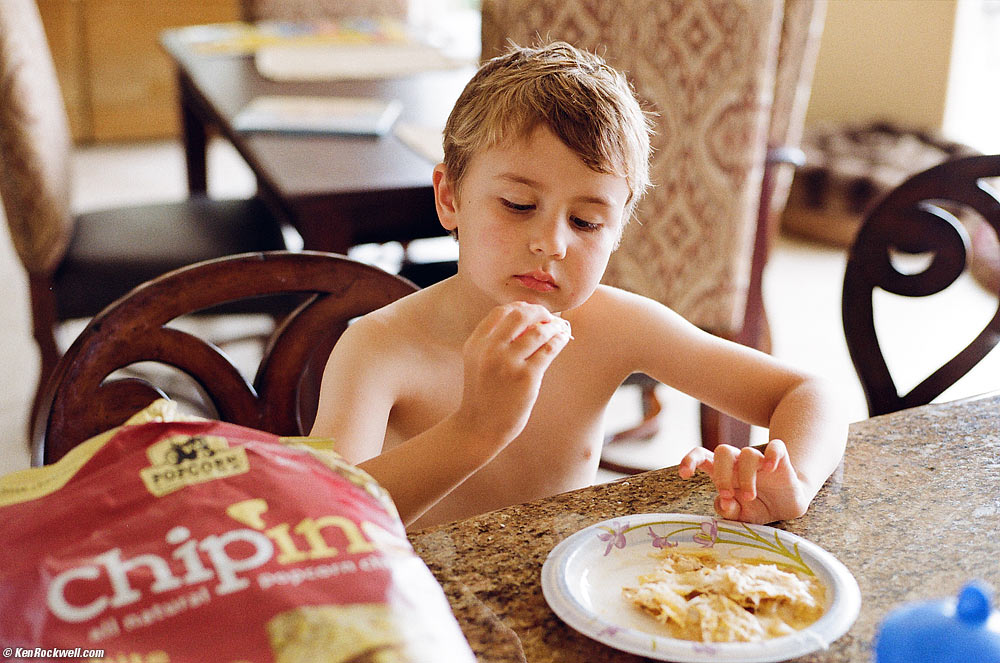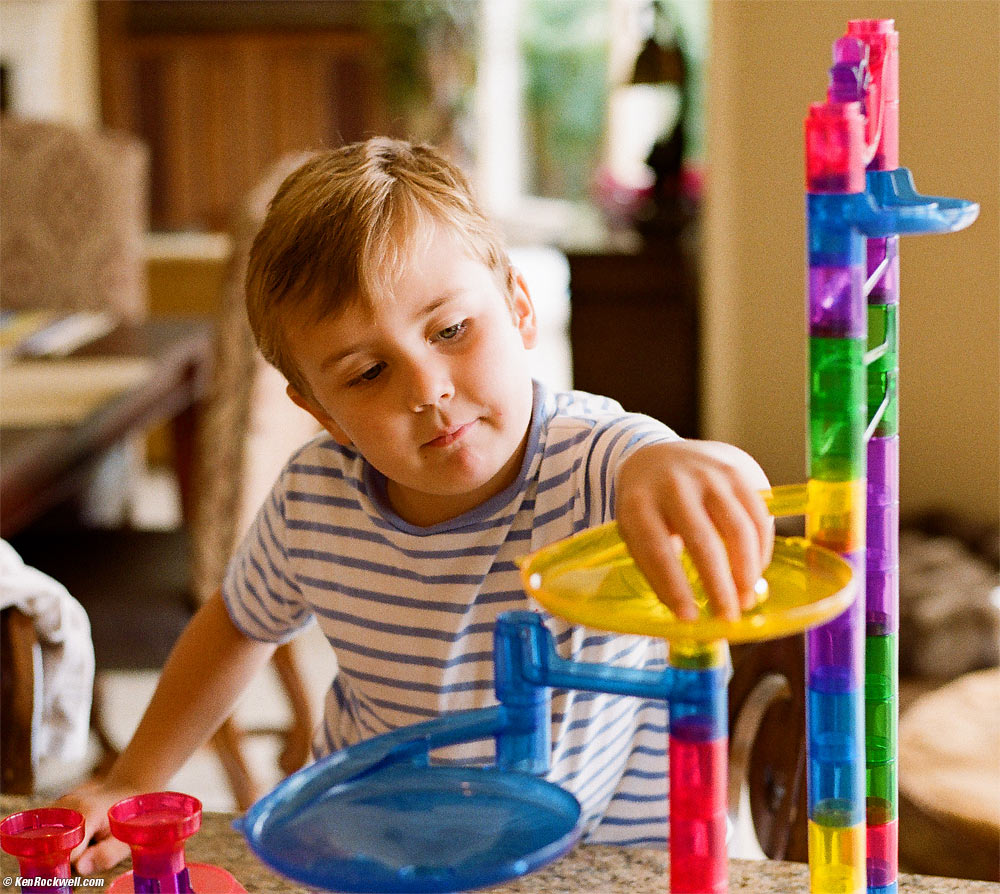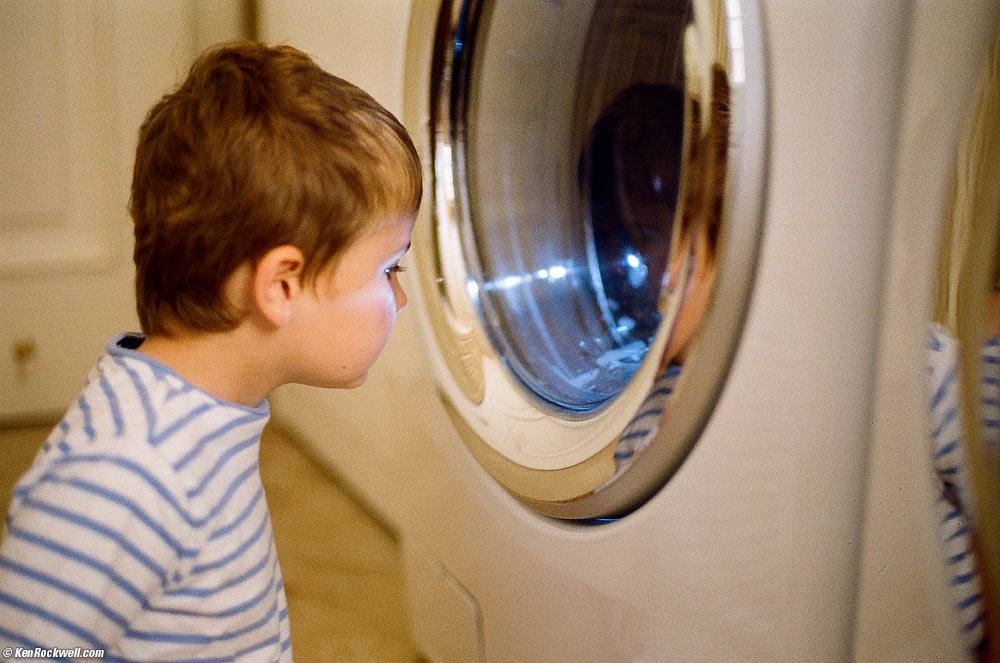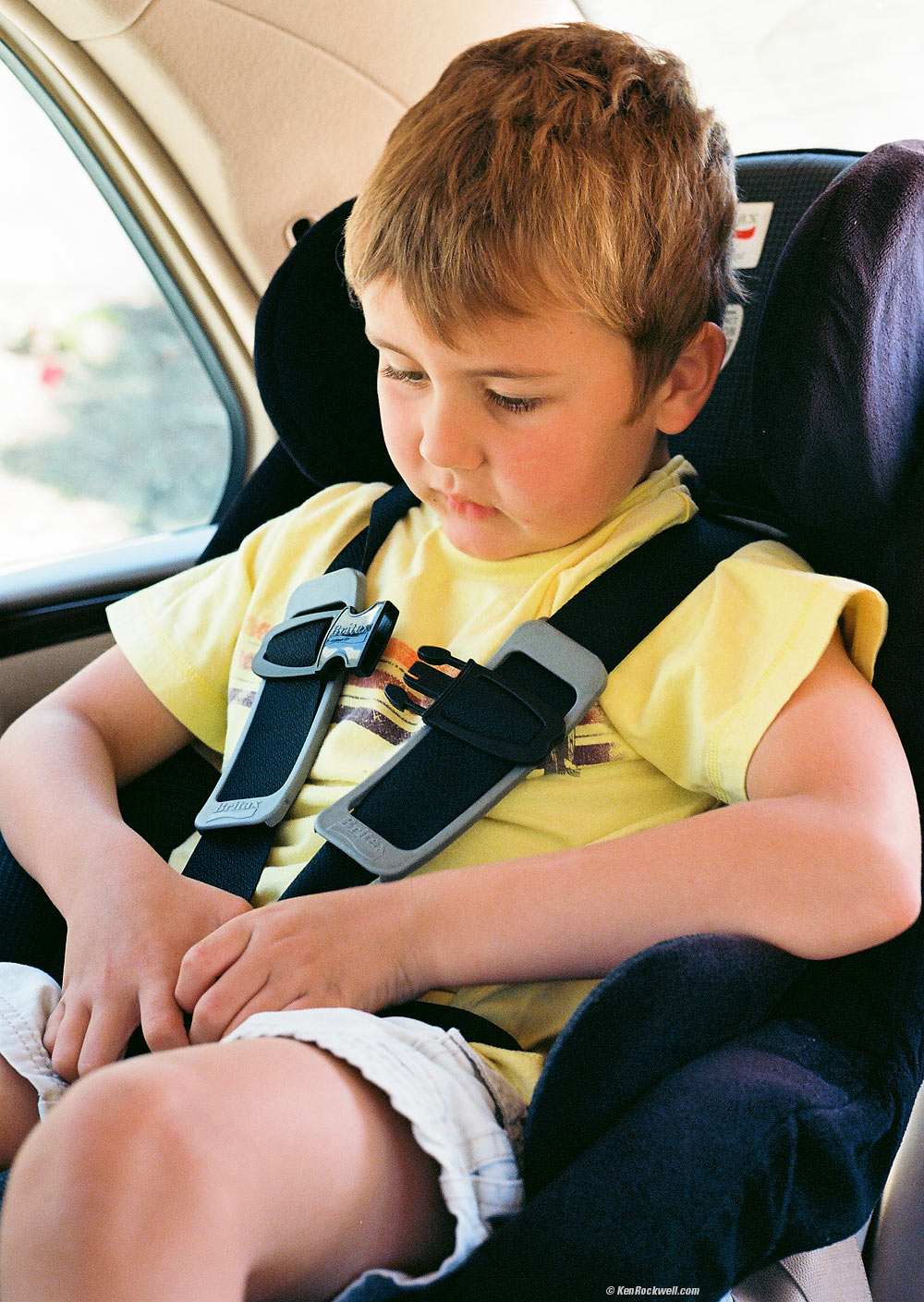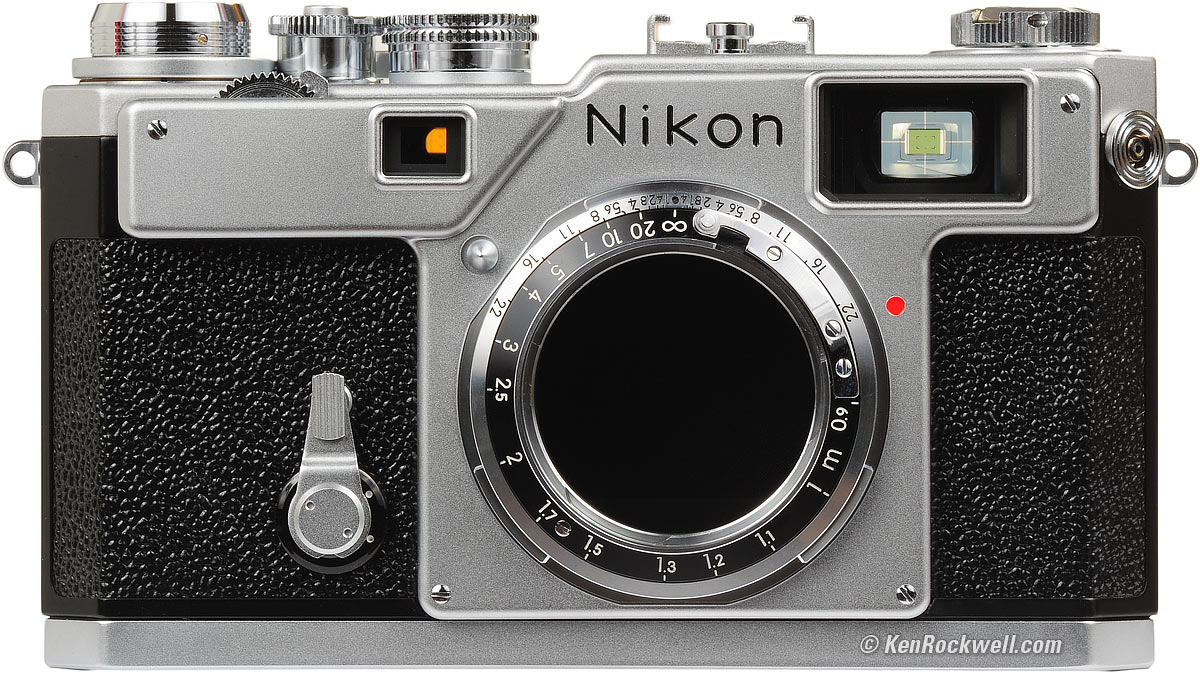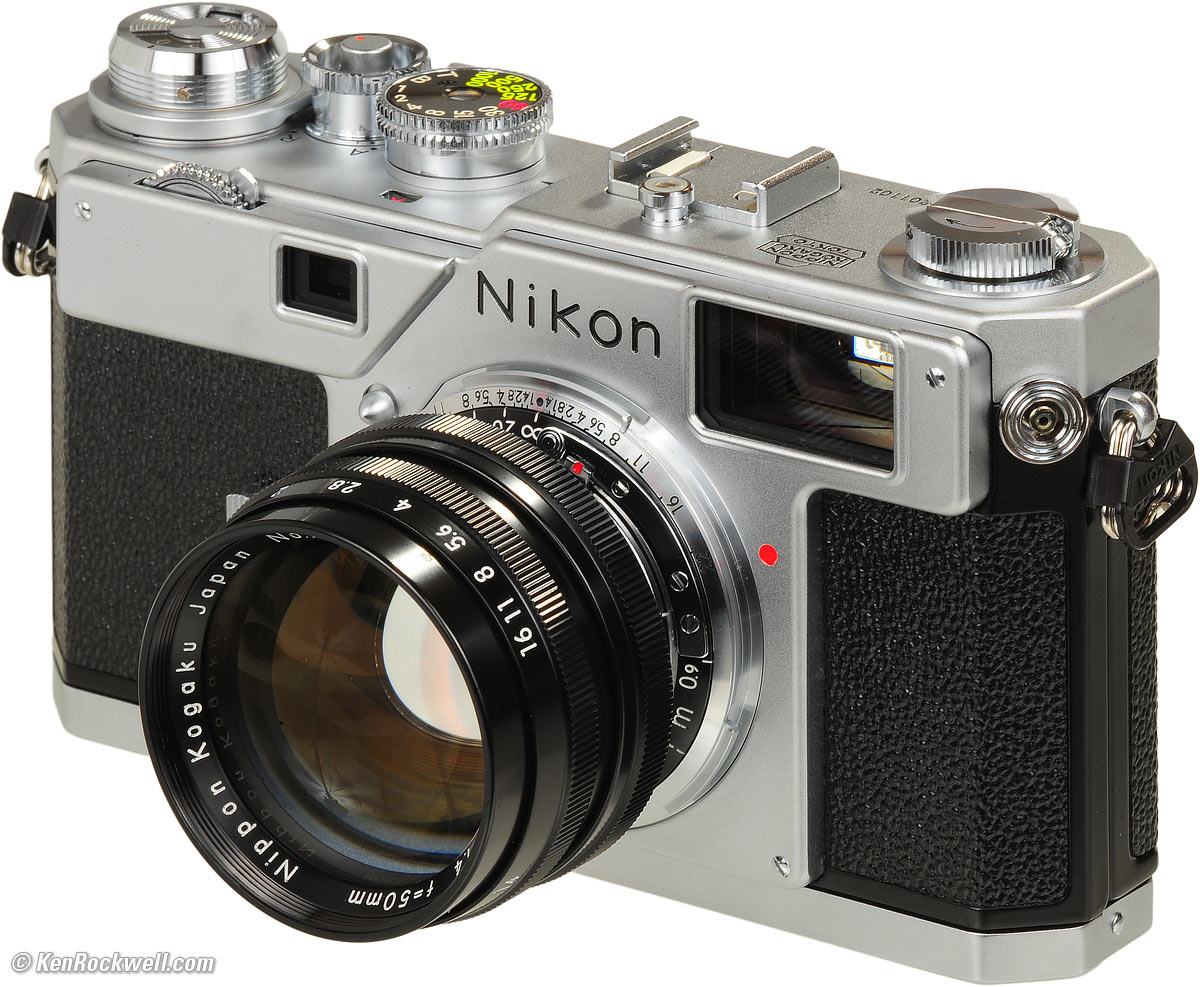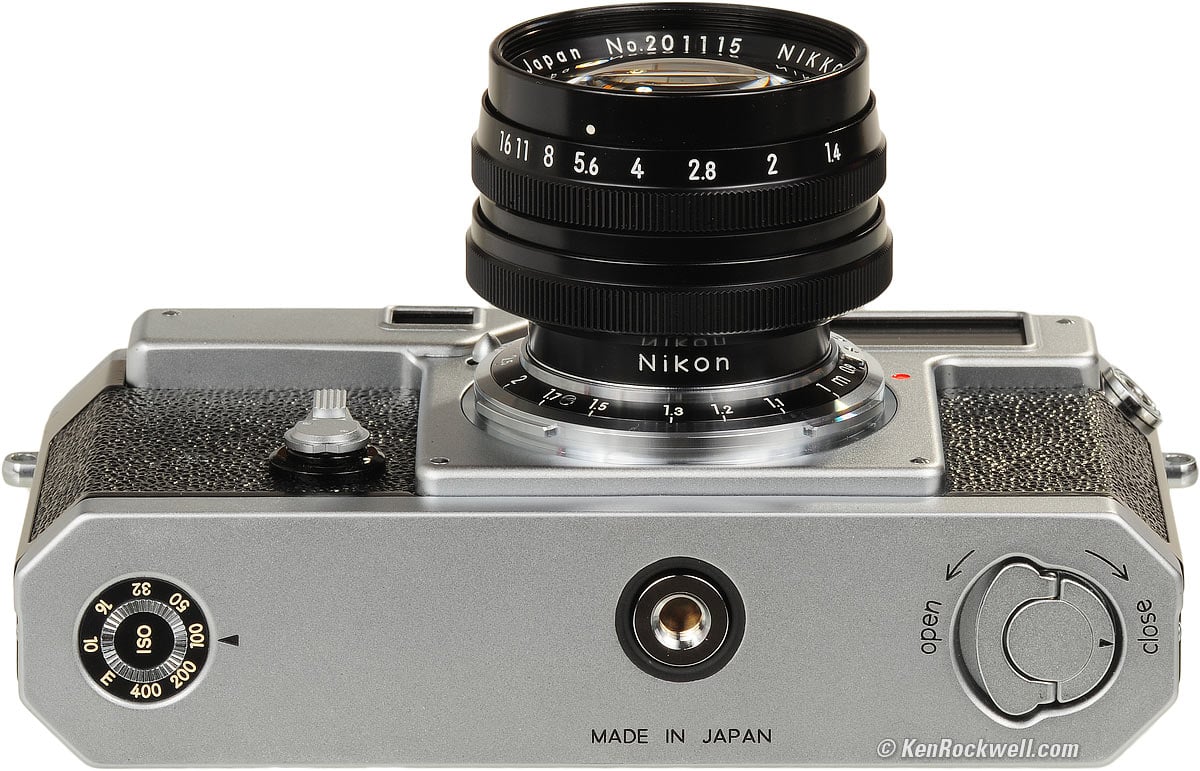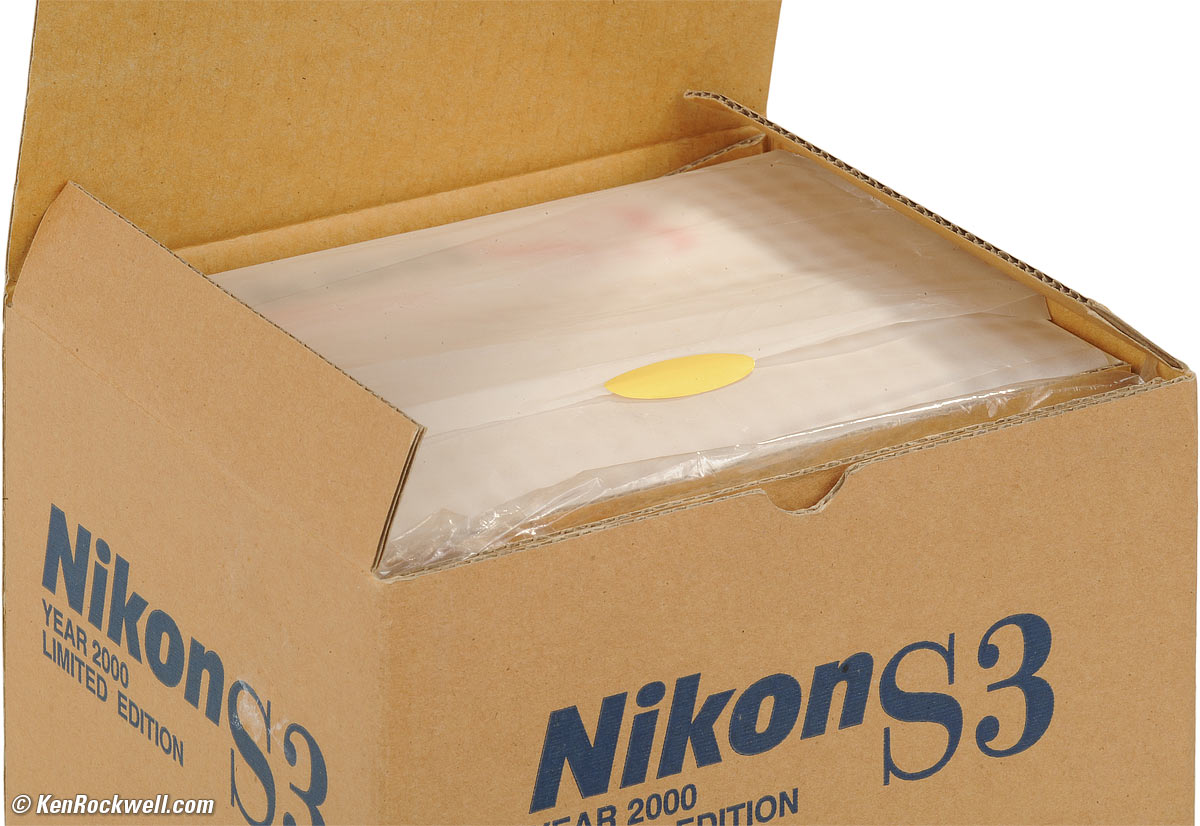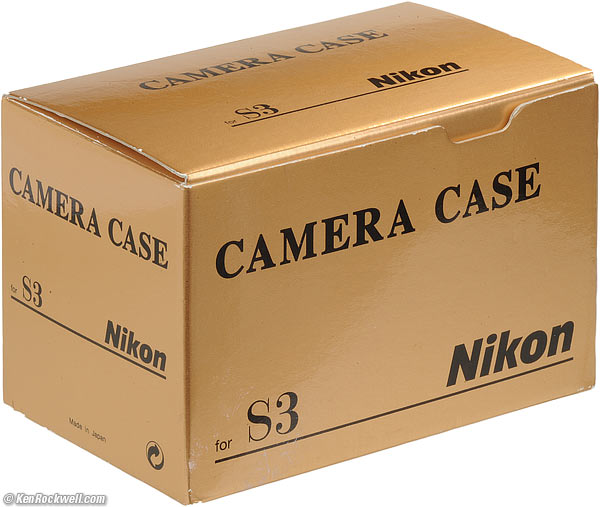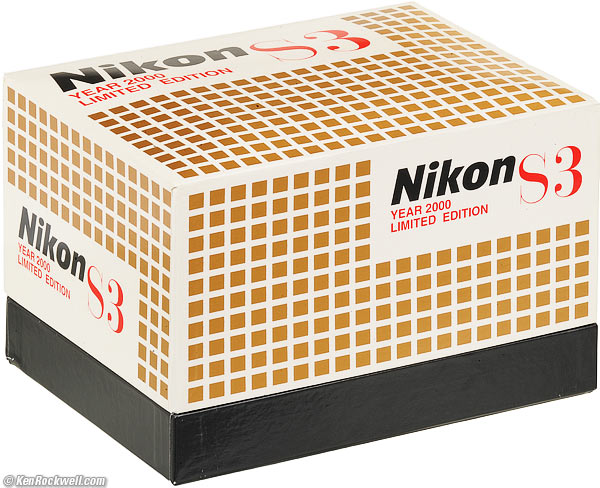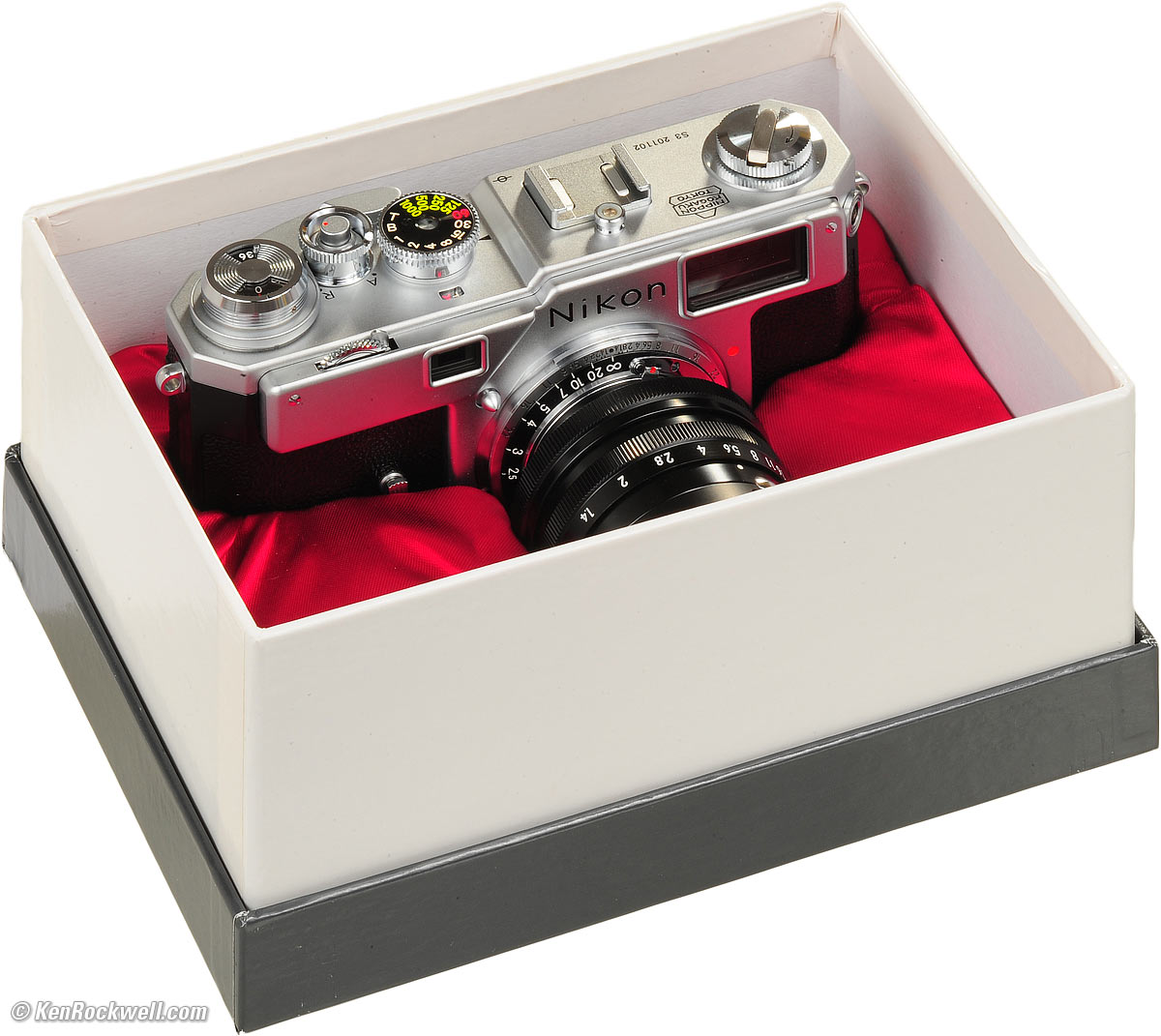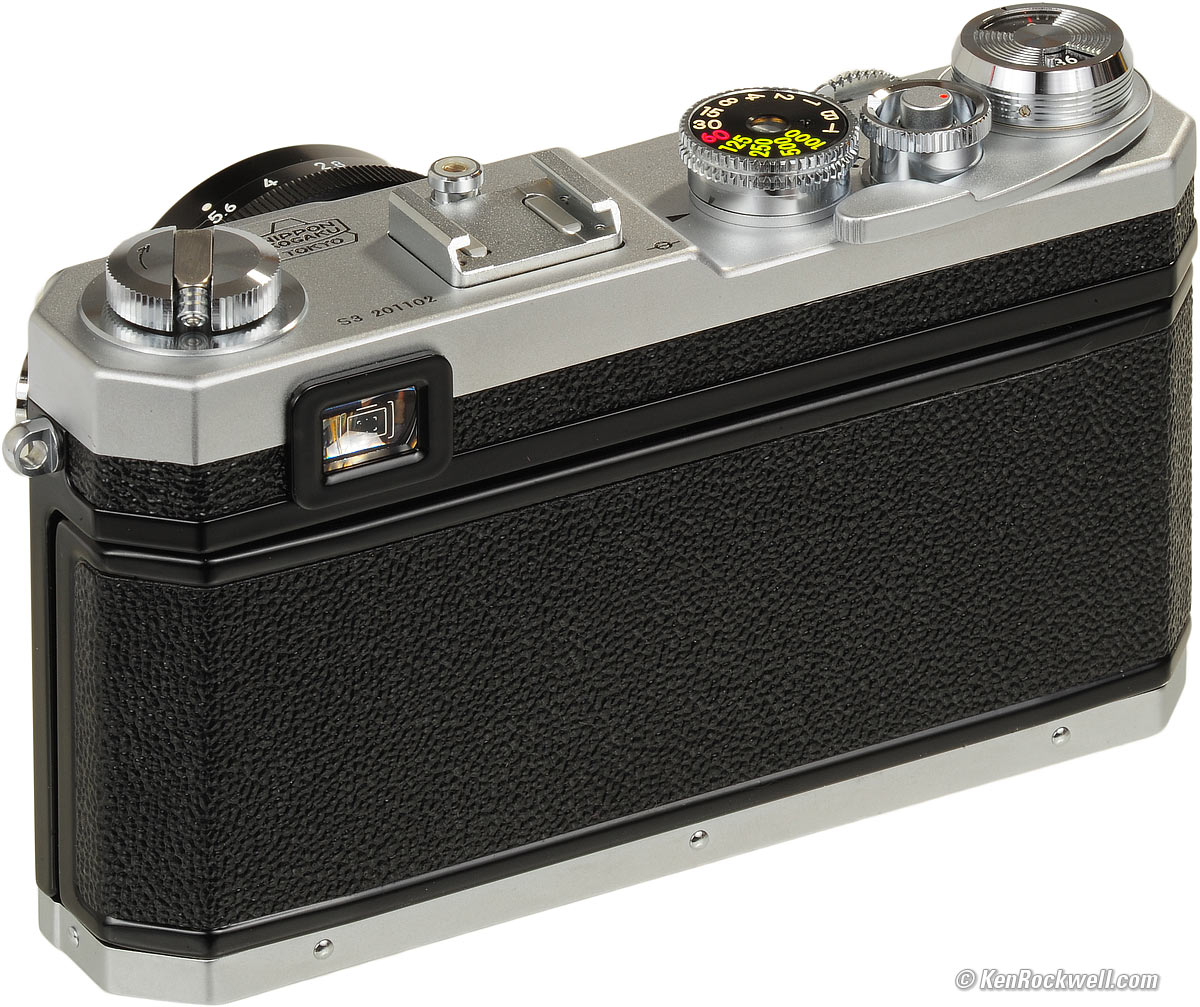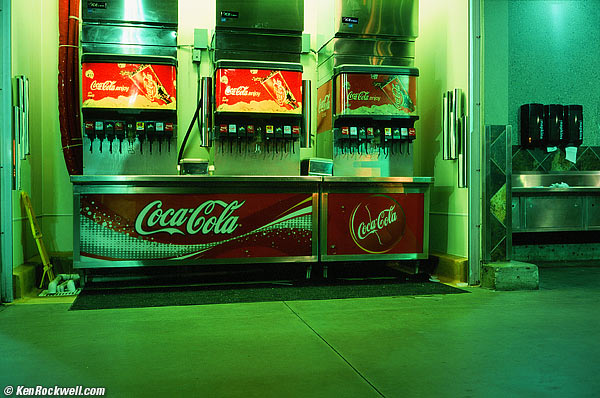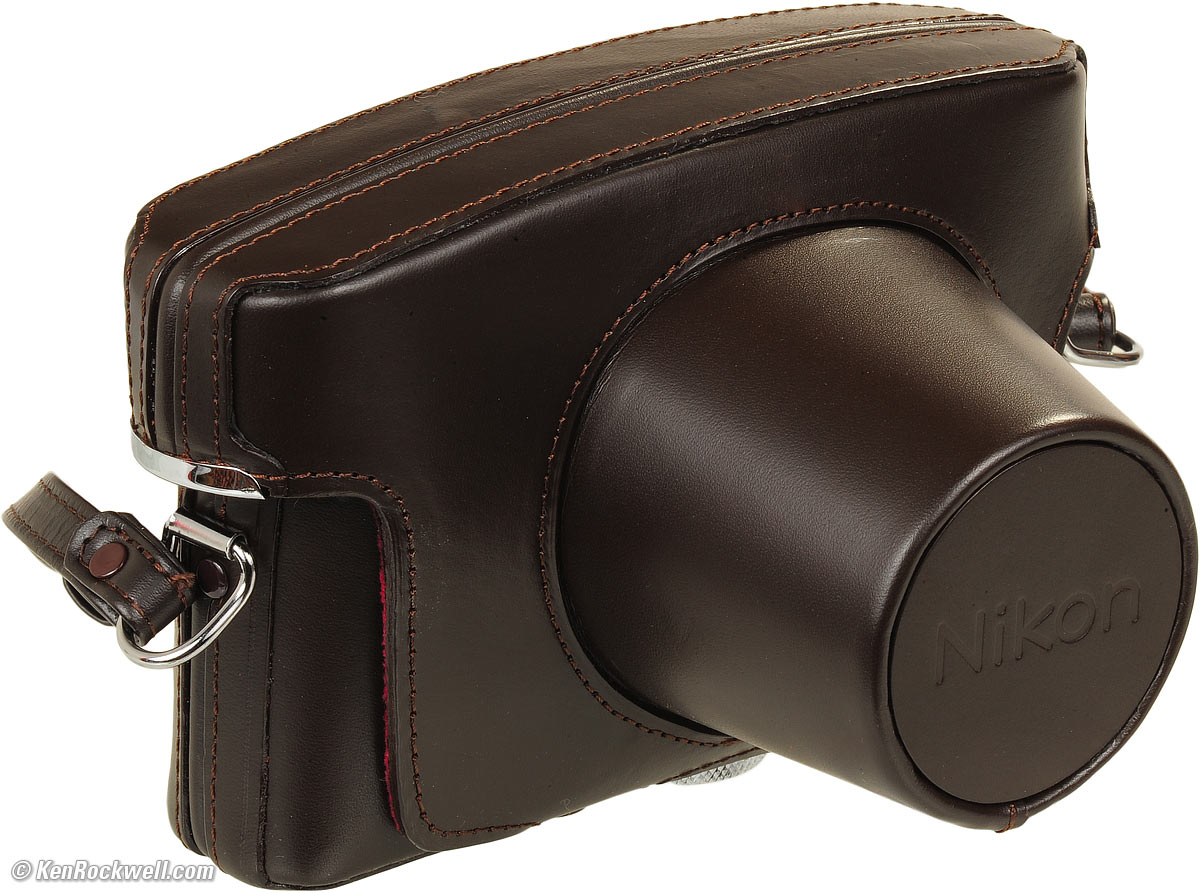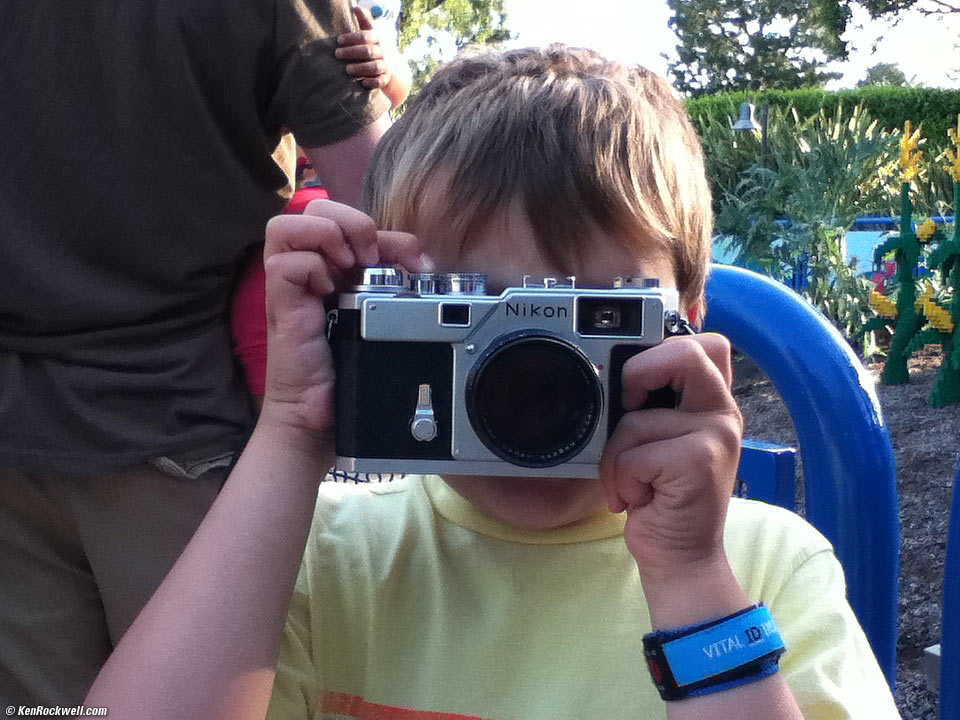Home Donate New Search Gallery Reviews How-To Books Links Workshops About Contact
Nikon S3
(1958-1964, Year 2000 Limited Edition)
Intro Specs Performance Compared Usage Recommendations More
Nikon S3 (Nikon S lens mount, 21.6 oz./612g with film; about $2,200 with NIKKOR-S 50mm f/1.4). enlarge. You can get them at this link to them at eBay; (see How to Win at eBay), and you also can get them at Amazon. It helps me keep reviewing these oldies when you get yours through these links, thanks! Ken.
April 2019 Better Pictures Nikon Rangefinder System Nikon System All Reviews
Why Fixed Lenses Take Better Pictures
Why Fixed Lenses Take Better Pictures
Rangefinder versus DSLR & SLR Cameras
Top, Nikon S3 2000 and NIKKOR-S 50mm f/1.4. enlarge.
Sample Image Files
Palm, 19 January 2013. Nikon S3 - Year 2000 Edition, 1957 Nikon W-NIKKOR•C 3.5cm (35mm) f/1.8 with 43mm Hoya 81A, 1/60 at f/5.6 at 16 feet at 10:17 AM, Fuji Velvia 50, NCPS process and scan, Athentech Perfectly Clear plug-in. Full-Resolution 3,600 DPI scan.
Fabric, 18 April 2012. Nikon S3 - Year 2000 Edition, Nikon NIKKOR-S 50mm f/1.4 (Year 2000) with 43mm Hoya 81A, 1/250 at f/6.7 at 0.9 meters at 12:20 PM, Fuji Velvia 50, NCPS process and scan, Athentech Perfectly Clear plug-in. Full-Resolution 3,600 DPI scan.
Dildoplant, 18 April 2012. Nikon S3 - Year 2000 Edition, Nikon NIKKOR-S 50mm f/1.4 (Year 2000) with 43mm Hoya 81A, 1/125 at f/5.6 at 2.5 meters at 12:22 PM, Fuji Velvia 50, NCPS process and scan, Athentech Perfectly Clear plug-in. Full-Resolution 3,600 DPI scan.
Nikon S3: The King of Candids:
Ryan eating the nachos he made all by himself, April 2012. (Nikon S3 Y2K, Nikon 50mm f/1.4, Kodak Gold 100, 1/60 at f/2.8, NCPS process and scan, Athentech Perfectly Clear.) bigger.
Ryan and his ball toy, April 2012. (Nikon S3 Y2K, Nikon 50mm f/1.4, Kodak Gold 100, probably 1/60 at f/2.8, NCPS process and scan, Athentech Perfectly Clear.) bigger.
Ryan staring at the dryer, April 2012. (Nikon S3 Y2K, Nikon 50mm f/1.4, Kodak Gold 100, 1/8 second hand-held at f/1.4, NCPS process and scan, Athentech Perfectly Clear.) bigger.
Ryan straps in for Legoland, April 2012. (Nikon S3 Y2K, Nikon 50mm f/1.4, Kodak Ektar 100, f/5.6 at 1/60, NCPS process and scan, Athentech Perfectly Clear.) bigger.
More Nikon S3 Sample Images from April 2012
Introduction top
Intro Specs Performance Compared Usage Recommendations More
Lens Compatibility History Price
|
|
The Nikon S3 is a wonderful camera, especially today in 2013. The Nikon S3 is much smoother and quieter than today's SLRs and DSLRs, with a super-smooth shutter release and huge 100% magnification viewfinder, and so much better built for a lifetime of great pictures.
The S3 is a no-BS camera: it just shoots, with a life-sized finder and zero shutter delay. With the S3, you have the pride of shooting a real Nikon, not a disposable plastic turd.
For only about $2,200 with fantastic NIKKOR-S 50mm f/1.4 lens, the Nikon S3 is one of the best rangefinder cameras still sold new today. It's better built even than today's LEICAs, with a bigger finder and much smoother shutter release.
This used to be a rare collectible, but as the collectors market has fallen out and prices have stabilized, the year 2000 Nikon S3 deserves to be bought, and then taken out and shot hard. By sold new today, I mean that it can be bought unused from collectors and their dealers unopened for about $2,200 if you know How to Win at eBay.
In its day the the Nikon S3 wasn't much compared to LEICA's M3, but today as LEICA's offerings have withered away for cost-savings (and as LEICA's prices have risen ridiculously without competition), the Nikon S3 offers many advantages as a great rangefinder camera today for not much more than a dirty little plastic Voigtländers or a clattery Zeiss Ikon.
You can buy a brand new Nikon S3, including the superb NIKKOR-S 50mm f/1.4 normal lens as shown here for about $2,200 today, but if you know How to Win at eBay, I only paid $1,800 for the camera and lens you're seeing here, complete with boxes, paperwork and leather case! A new LEICA body will cost you five grand without a lens. Voigtländers cost less, but are plasticy toys for hobbyists, not all-metal masterpieces like the Nikon S3.
The S3 is an expertly-crafted, all-metal masterpiece with a life-size finder and a rangefinder spot that doesn't flare, as LEICA's cost-reduced rangefinders since 1967 do. With a life-size finder, never seen on any LEICA, it's easy to compose, focus and shoot with both eyes open.
Nikon originally introduced the S3 in 1958 as a cheaper version of the professional Nikon SP, introduced in 1956. The S3 just happens to have the world's first life-sized 35mm-coverage viewfinder, something never, ever achieved by LEICA.
Nikon pulled out all the stops for Year 2000, and reintroduced the S3 as a limited-edition, sold only in Japan. You had to win a Japanese lottery to be able to buy one of the only 8,000 sets made of the Year 2000 Limited Editions, which sold for about $6,000 each. Each set included a brand-new NIKKOR-S 50mm f/1.4 lens and real leather case.
The Y2K version is a special edition done right: something genuinely commemorative and better than current products. It's even improved over the original!
While collectors fell over themselves to pay about $6,000 for each of these commemorative editions back in 2000, they sell for only about $2,200 today complete with superb lens, still unused. Therefore, if you want a superb, brand-new rangefinder camera built a bit better than even today's LEICAs, look into the Nikon S3.
Don't ever believe it if Nikon tries to say it can't do something: if it can make brand-new SPs and S3s, it can make anything it wants to. Never say never.
Far better than any weak LEICA commemorative, Nikon's Y2K commemorative S3 is actually slightly improved on the original. LEICA's commemoratives are always the current camera with a funny name put on it, while Nikon went back and remade all the dies and molds and remanufactured the camera better than the original! All of LEICA's cameras have been downgraded for lower cost ever since the LEICA M3; LEICA's commemoratives are always an embarrassment when compared to the original M3.
The astounding thing is that the differences between the new and old versions are improvements, not cost-reductions. For instance, the new rewind crank now has a rotating tip instead of just solid metal, the new strap lugs are solid stainless steel instead of common brass, and the front cap is now aluminum instead of the original plastic. I've never seen LEICA do a commemorative like this! The Nikon S3 Year 2000 is a class act all the way, and a deal at 2013's prices for a hand-made professional camera.
Since both this S3 and the SP commemorative versions are available new, these two cameras are actually the best recently-made rangefinder cameras! All LEICA has done since the 1960s are much crappier cameras with cost-reduced reducing viewfinders with rangefinder spots that flare — not all-metal cameras with life-size finders like these Nikons.
I'm reviewing one of the Year 2000 Nikon S3s, with the silk shutter. The original 1950s cameras are the same, with only minor differences. Therefore, this review applies to all Nikon S3s.
Front, Nikon S3 2000, showing focus scale and 50mm depth-of-field scale. enlarge.
The Nikon S3 uses the Nikon's S bayonet mount. The S-mount is compatible with all Nikon rangefinder lenses, but completely incompatible with any of Nikon's SLR system, which has used the F mount since 1959.
The S-mount is copied from Contax, whose lenses also mount. The gotcha is that Contax' 50mm lenses had slightly different focal lengths from Nikon's, thus the rangefinders become progressively less compatible at closer distances.
Nikon made all sorts lenses, from a 21mm f/4 through a 50mm f/1.1 (!) to a 1,000mm f/6.3 (with reflex viewing attachment!) for this system.
For most people, lenses from 28mm though 135mm were most popular, and that's what you'll see most often today. The crazier lenses weren't very popular so collectors today have bid prices out of line for actual photography, while normal lenses usually sell for a couple of hundred dollars.
1930s
Nikon's first camera lenses were used on the very first Canon (Kwanon) camera of 1934. This wasn't any sort of competitive problem since Nikon didn't make cameras.
1941~1945
Before World War II, Nikon was primarily a manufacturer of military optical instruments. Nikon's products were used in Japan's terrorist attacks on Pearl Harbor on December 7th, 1941, and Nikon's bombsights, periscopes, large naval binoculars and ultra-long range optical rangefinders used with battleship artillery were instrumental in the deaths of many innocent Americans in World War II.
After America harnessed the same force from which the Sun draws its power to bring freedom to Japan in the summer of 1945, Nikon's warmongering activities were disbanded.
The few employees left at Nikon wondered what to do. Shrugging their shoulders, they decided to make a small 35mm rangefinder camera for consumers.
1947
Nikon's first camera was the Nikon One. It copied the lens mount and top focus wheel from Contax' cameras.
The Nikon One was followed by the Nikon M and Nikon S, and then the Nikon S2, which was the first Nikon to use Leica's now-standard 24 x 36mm full-frame. Earlier cameras used better, slightly less wide 35mm frames.
1957
Nikon's first professional camera, the Nikon SP, added finder frames for every lens under the sun. It did this with a tiny second finder next to the main finder.
1958
This Nikon S3 is introduced as a lower-cost version of the Nikon SP. It adds the 35mm frame to the main viewfinder, but loses the peephole 28mm finder and some other features of the SP.
Year |
Format |
Finder Mag. |
Finder |
Top Speed |
|
| Nikon One | 1947 |
24 x 32mm |
0.60x |
50mm |
500 |
| Nikon M | 1949 |
24 x 34mm |
0.60x |
50mm |
500 |
| Nikon S | 1951 |
24 x 34mm |
0.60x |
50mm |
500 |
| Nikon S2 | 1954 |
24 x 36mm |
1.00x |
50mm |
1,000 |
| Nikon SP | 1957 |
24 x 36mm |
1.00x |
28, 35, 50, 85, 105, 135 |
1,000 |
| Nikon S3 | 1958 |
24 x 36mm |
1.00x |
35mm, 50mm, 105mm |
1,000 |
| Nikon S4 | 1959 |
24 x 36mm |
1.00x |
50mm, 135mm |
1,000 |
| Nikon S3M | 1960 |
18 x 24mm |
1.00x |
35mm, 50mm, 135mm |
1,000 |
Nikon's later rangefinder cameras were cheaper, simpler versions of the Nikon S3, much as LEICA's newer cameras since the 1950s have also been cheaper, simpler versions of the LEICA M3.
1959
Nikon replaced their cameras' original Habutae silk shutters with the same titanium shutter used in the 1959 Nikon F.
Believe it or not, Nikon's first SLR, the Nikon F of 1959, is actually just a Nikon S3 with a prism glommed on!
The shutter, layout, controls, and camera back are all otherwise the same between this Nikon S3 and the Nikon F SLR.
NIkon turned this grafted-on prism kludge into a marketing ploy that worked all the way up to 1999, when the Nikon D1 was Nikon's first-ever professional SLR that didn't have an interchangeable prism!
Even the S3's removable back is the same in the Nikon F, except that the Nikon F is a little bit wider, but otherwise identical.
1962
By 1962, everyone had moved to the Nikon F SLR, or to the extraordinary LEICA M3, and Nikon's rangefinder cameras were promptly forgotten.
Nikon sold less than 23,000 Nikon S3s, which is why they gave up. LEICA sold 250,000 M3s. In fact, Nikon sold less than 140,000 rangefinder cameras in its entire history, or about half as much as LEICA sold of just the LEICA M3.
1970s
By the 1970s, Nikon's SLRs had pretty much killed off LEICA and the rangefinder market. Nikon had won.
2000
Nikon got crazy for year 2000, and out of nowhere decided to reintroduce this Nikon S3. Nikon even redesigned the original 50mm f/1.4 lens and included this extraordinary new 50mm rangefinder lens as part of a commemorative set.
Nikon also made about 8,000 of the Nikon S3 and 50mm f/1.4 combo in 2000, and only for sale in Japan.
2005
Nikon got even crazier, and even though they claimed that the extremely complicated finder system of the Nikon SP couldn't be reproduced, indeed introduced a new run of new Nikon SPs — even though no new Nikon SLRs had come out since the F6 of 2004!
Nikon reintroduced a limited run of 2,500 copies of the Nikon SP, complete with brand-new 35mm f/1.8 lenses. These were sold factory-direct to the faithful in Japan with a lottery system.
If you want one today, often you can find beater original 1950s bodies for $500, and with a lens like the 50mm f/1.4 in great cosmetic shape in perfect working order, some dealers may ask as much as $2,000 for an original.
If you want a new camera to shoot, a copy of the year 2000 commemorative edition sells for about $2,000 ~ $2,400, still like new.
When these sold new in the 1950s, Nikons sold for 3/4 the price of similar LEICA equipment.
Both Nikon and LEICA equipment was insanely expensive in the 1950s. In the 1950s, most cameras were made of bakelite, and fine equipment like this was only used by career professionals and the very rich.
Normal people couldn't even start thinking about buying either. A LEICA M3 and 50mm f/1.4 lens sold for about $4,000 in today's (2010's) money, while a Nikon S3 and 50mm f/1.4 lens went for only about $3,000.
By the 1970s, rangefinder cameras had gone obsolete, replaced by Nikon's SLRs like the Nikon F and Nikon F2.
In the 1970s, Nikon rangefinder cameras were given away, and for $20, you could pick up an S3. It's just like today, where $25 picks up a Nikon FE.
As these rangefinder cameras get older, guys who are rich today but were only in their teens and twenties back in the 1940s and 1950s grow nostalgic for the great luxuries they couldn't afford back then, and thus the used prices of these cameras has made it into collector territory.
Specifications top
Intro Specs Performance Compared Usage Recommendations
Film
Standard 35mm "135" film.
Standard 24 x 36mm frames.
Lenses
Nikon S bayonet mount (not compatible with SLR lenses).
Focus Distance
Infinity to 0.9 meters (with 50mm lens).
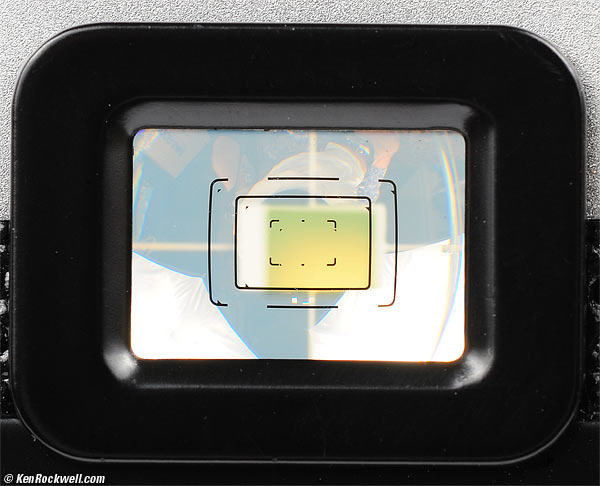
View of eyepiece showing three framelines, Nikon S3 2000.
Rangefinder Base Length
60.5mm, both actual and effective.
Main finder
1.00x magnification.
No parallax correction. The frames are fixed, with little tits for close distances.
35mm, 50mm and 105mm frames, all always displayed.
Type
Horizontal focal-plane.
Material
1957-1958: Habutae silk.
1959-1962: The same titanium foil as the Nikon F.
2000: Rubberized silk.
Speeds
Time, Bulb, and 1s - 1/1,000.
Knob
Rotates continuously through 360.º
Rotates from 1/1,000 directly to Time, Bulb or 1 second if you like; it doesn't stop.
Self Timer
3 to 10 seconds, adjustable by how far you turn the lever.
Marked at 3, 6 and 10 seconds.
Cable Release
Needs a screw-over cable release from the LEICA screw mount cameras, or a nipple adapter for use with ordinary cable releases.
The S3 has the same shutter button and cable release connections as the Nikon F and F2.
Wind Lever
136,º single or multiple strokes.
15º preparatory offset if you like.
Solid metal.
Back
Removable.
Won't work with motor drive.
Frame Counter
Additive (counts up).
Auto resetting.
Numbered at 0 and every 5 and 10.
Lines for every frame from 0 to 36. Stops at 36.
Lines at 24 and 36 are red.
I shoot all frames, and get 39 shots per roll of Fuji 36.
Nikon offered an accessory coupled selenium meter, not offered in 2000.
It came with an opal plates for incident metering.
It used a flipping baffle for selecting between low and high light ranges.
An optional booster was available for very low light.
PC Sync Terminal on Front RIght, Nikon S3 and NIKKOR-S 50mm f/1.4. enlarge.
PC (Prontor-Compur) socket and special dedicated cordless terminal at accessory shoe. If you use the BC-5 flash, no cords are needed to synchronize to the camera for firing.
Synchronization is semi-automatic, set by lifting and rotating the shutter dial.
FP flashbulbs: up to 1/1,000.
Electronic flash: up to 1/60. Select "FX" for electronic flash. (see my Nikon SP User's Guide for the specifics.)
Bottom, Nikon S3 and NIKKOR-S 50mm f/1.4. enlarge.
Modern-standard 1/4" - 20, right under the lens.
The people who paid $6,000 for this commemorative model expected some nice boxes.
When you get the same thing today for about $2,200 from a collector you still get a corrugated outer box that holds two smaller boxed inside, both wrapped and sealed together in Vellum. The bottom of the outer box has bar code stickers with the serial numbers of the body and of the lens, as well as the UPC bar code for the whole set:
Outer Box, Nikon S3 Year 2000. bigger.
In this outer box is the box for the case:
Box for case, Nikon S3 Year 2000.
And the box for the camera and lens. This box has a padded top:
Open this box to see your new S3 and 50/1.4:
Boxed Nikon S3 Year 2000. bigger.
Everything is Made in Japan.
4 960759 022066
BC-6 battery-capacitor flashgun.
BC-5 cordless battery-capacitor flashgun.
BC-3 battery-capacitor flashgun.
21.587oz. (612.0g) with RVP50-135-36, without lugs.
21.575 oz. (611.5g) with 135-36 TMX 100 film, without lugs.
20.810 oz. (589.9g) without film or strap lugs.
Nikon rates it as 20.8 oz. (590g) empty, or 27.0 oz. (765g) empty with new 50/1.4.
(The Nikon SP is 21.273 oz. (603.05g) with film and strap lugs, but without strap, lens or cap; or 20.493 oz. (580.95g) without film.)
1958, and again in 2000.
Performance top
Intro Specs Performance Compared Usage Recommendations More
Overall Durability Ergonomics Finder Focus Shutter Film Rewind Case
The Nikon S3 is a great camera, in most ways superior to the overpriced DSLRs of today.
The S3 is quiet, smooth and competent at everything for which rangefinder cameras are well suited.
Durability performance top
If you find an original 1950s Nikon S3 that has never been serviced, unlike a LEICA, it's quite likely that its shutter still works perfectly. Its finder may be quite cloudy and dark, making it almost useless before it's overhauled.
These service men have no problems finding parts or working on it.
If it's been taken care of, the shutter curtains, be they silk or titanium, ought to be fine.
The removable back uses nothing except tight tolerances to seal it, and there are no mirrors to cushion, thus the Nikon S3 use no foam seals. You'll never have a problem with gummy foam seals as you often do on SLRs.
Unlike the crap sold today pretending to be cameras, the S3's insides are all metal. The Nikon S3 uses a solid metal film sprocket and solid machined-metal take-up spool — not plastic or stamped steel.
If you get a Year 2000 edition, expect it to last at least another 50 years without any need for service or adjustment.
Ergonomics performance top
The Nikon S3 is a very pleasant camera to shoot, so long as you avoid using the razor-wheel (near the shutter button) to focus with a heavy lens.
There's no automatic frameline switching; all three frames are always visible.
There is no parallax correction; use your brains and the extra marks in the finder.
Rear, Nikon S3 and NIKKOR-S 50mm f/1.4. enlarge.
The razor wheel is a very sharp toothed wheel just in front of the shutter button that can be used to focus 50mm and wide-angle lenses from the top of the camera. The good news is that you can use your middle finger to focus, your pointer finger to shoot and your thumb to advance film for fast shooting, but the bad news is that the razor wheel eventually cuts through your finger.
It's easier to use the top-mounted A-R (rewind) ring on top than having to turn over the camera to press a rewind button on the bottom.
The shutter dial turns 360,º making it easy to go directly from 1/1,000 to Time, Bulb or 1 second without having to turn the dial all the other way around.
The lenses are small, but heavy. Fill a small bag with the tiny lenses and you'll feel it!
The life-size finder is wonderful: frame and focus with both eyes open and shoot LIVE!
The dials of the S3 are eminently legible in any light.
Film loading is easy, and easier than any LEICA ever. The back pulls off the S3, and then the film loads right up as it should, without having to poke anything into the dark holes of a LEICA.
For some unknown reason, my frame counter index line isn't aligned when I view the counter from directly above; it is if I view it from my actual shooting position to the side.
Oddly, the ISO clicks on the bottom film reminder go at half-stop clicks. It only lets you mark the film's ISO, but not what kind of film (color, slides, negatives, daylight, tungsten, etc.) you have loaded.
The wind lever is ratcheted and has an offset.
The rewind crank has a rotating tip in the Year 2000 version, but it's just a solid lever in the original 1950s version. (The 1950s SP rewind crank is also solid.)
Viewfinder performance top
The life-size finder is excellent, however it's always cluttered with all the framelines at the same time. It's fine for use with the 50mm and 105mm, but what sounds like a wonderful full-size 35mm finder is cluttered with a very bold 50mm frame that gets in the way.
Since it's life-sized, feel free to keep both eyes open for composition as well as for focussing. The 35mm frame is easiest to see with both eyes open. Its frame lines are at the edges of the finder's field of view.
The frame lines are additive; they don't hide the subject.
Better than most cameras, the finder has no geometric distortion.
As expected, the finder errs on the safe side, which often leads to looser compositions on film.
Better than the Nikon SP, the finder is neutral colored, just like LEICA.
It's got coated finder optics, just like the SP.
With the 3.5cm (35mm) f/1.8:
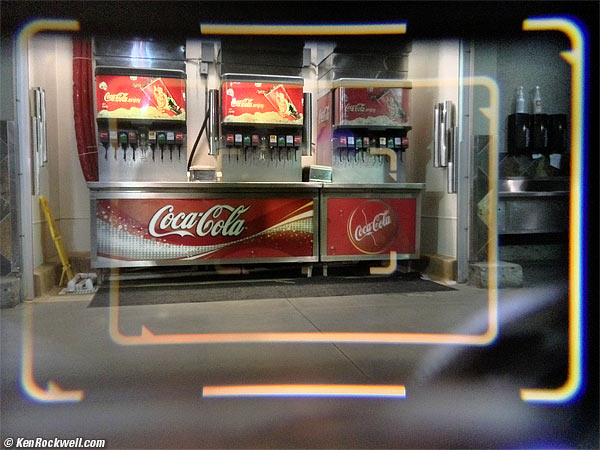
Viewfinder view. Subject at 17 feet. Note lens incursion in lower right. Dark top caused by the way I photographed this view; it looks much better by eye.
Resultant image, Coke Machines, 19 January 2013, 6:39 PM. They're green beacause that's the way mercury lights register on daylight film. (Nikon S3 - Year 2000 Edition, 1957 Nikon W-NIKKOR•C 3.5cm (35mm) f/1.8 with 43mm Hoya 81A, 1 second at f/3.5 at 17 feet, braced on table by hand, Fuji Velvia 50, NCPS process and scan, Athentech Perfectly Clear plug-in.) bigger.
The 35mm lens blocks a little in lower right corner of the 35mm finder.
The 35mm lenses come up to about the lower right corner of the 50mm frame.
If you use the hood, you'll loose a lot more.
The finder frame is a bit loose on left and top, and just about perfect on right.
The 35mm frame covers a little more than does the finder of the SP (images are a bit looser).
With the new 50mm f/1.4:
The 50mm frame covers a little more than does the finder of the SP (images are a bit looser).
The 50mm lens blocks a little in lower right corner of the 50mm finder.
The lens comes up to about halfway between the lower right corners of the 50mm and 105mm frames.
If you use a hood, you loose more.
The 50mm frame is perfectly loose on top and right, very loose on the left at far distances. The top and left and right perfect at close distances. At 0.9m, left and right are AOK, the top is too close and leads you to crop a little.
With the 10.5cm (105mm) f/2.5:
The coverage of the 105mm frame is about the same as in the SP.
The lens blocks just a little of the lowest right corner of its own 105mm finder line. It's not significant, at least without a hood.
The 105mm frame just a little loose, which is perfect.
Focus and Rangefinder performance top
The rangefinder spot is less contrasty than the LEICA M3 or LEICA M9. The spot has fuzzy, not sharp edges, so you never really know where it's located or where the perfect spot is for your eye.
Unlike newer LEICAs, the S3's rangefinder spot doens't flare when pointed into the light.
The rangefinder is ultra precise; the lenses turn very slowly and the effective base length is longer than anything from LEICA introduced in the past 50 years.
The rangefinder spot moves backwards from the lens, but matches the razor wheel.
The lens' focus rings turn in the same direction as Nikon DSLRs today.
The focus feel of most lenses is precise and dry. It takes a lot lot of rotation, about 270,º to get from infinity to 0.9 meters (3 feet). Therefore, you'll be spinning the lens a lot and getting bang-on focus.
With rangefinder cameras, every body and every lens will focus slightly differently. My particular sample focused an imperceptible hair behind the intended focus with all of my Year 2000 50mm f/1.4, original 1957 35mm f/1.8 and 1957 105mm f/2.5. It was such a small offset that it's well within the actual depth of field wide-open seen at 36 times magnification (36 x 54" prints).
Depth of Field Scale
The depth of field scale on the S3 body for the 50mm lens and on each of the other lenses is calculated with the same 30µm circle-of-confusion as today's 35mm camera lenses; no news here.
Shutter performance top
Trigger Pull
One of the nicest things about the Nikon S3 is how quiet and smooth are its shutter and its shutter release button.
It's one smooth, unkinked push to shoot. There are no kinks or detents in the shutter relase, thank goodness.
Shutter Accuracy
Shutter accuracy is exemplary.
In the bad old days of the 1950s from which the Nikon S3 comes, mechanical shutters were usually reasonably close at slow speeds, and slow a half stop at 1/500 and slow a full stop at 1/1,000.
This mechanical Year 2000 Nikon S3 is marvelous: within ± 0.01 stops at the most important speeds of 1/60, 1/125 and 1/250, and within ± 0.08 stops over the full 1 second ~ 1/250 range. As expected, 1/500 is 1/3 stop slow, and 1/1,000 is 2/3 stop slow.
Anything within a third of a stop is practically perfect even shooting slide film, so ± 0.08 stops is perfect.
Bravo!
Setting |
Actual |
Error (stops) |
1957 SP Actual |
1957 SP Error (stops) |
1 |
1.02 s |
+0.03 |
0.94 s |
-0.1 |
2 |
0.48 s |
-0.06 |
0.459 s |
-0.12 |
4 |
0.24 s |
-0.06 |
0.235 s |
-0.09 |
8 |
0.132 s |
+0.08 |
0.114 s |
-0.13 |
15 |
65.50 ms |
+0.07 |
61.55 ms |
-0.02 |
30 |
32.25 ms |
+0.05 |
31.23 ms |
-0.0009 |
60 |
15.70 ms |
+0.01 |
16.90 ms |
+0.11 |
125 |
7.80 ms |
± 0.00 |
7.90 ms |
+0.016 |
250 |
3.90 ms |
± 0.00 |
3.93 ms |
+0.007 |
500 |
2.35 ms |
+0.27 |
1.75 ms |
-0.156 |
1000 |
1.69 ms |
+0.80 |
1.02 ms |
+0.06 |
(S3 Y2K shutter measured 17 April 2012)
Sound
The silk shutter is much quieter than SLRs.
It's quiet, but a little clackier than the silk shutter of the early Nikon SP.
Dial
The big, bold shutter dial rotates 360° without stops.
The gear teeth on the dial mesh with the slip-on light meter (not included).
Time and Bulb Settings
There are both the usual Bulb as well as Time (T) shutter settings. When set to Time, the shutter stays open until you change the dial to another speed.
Cable Releases
The cable release is copied from LEICA screw mount cameras. You need either a screw-over cable release, or a nipple adapter to use with regular cable releases.
Film Economy performance top
If you shoot frame 0 as I do, you'll usually get 39 frames on a roll of 36.
Manual Rewind Speed performance top
10 seconds.
Leather Case performance top
Real Leather Case, Nikon S3 Year 2000. bigger.
The soft, thick leather case is the usual two-piece job.
The big attachment screw on the bottom is also tripod threaded, so there's no need to pull the camera out of its case for tripod shooting.
Compared top
Intro Specs Performance Compared Usage Recommendations More
Compared to the Nikon SP, the Nikon S3 has a much simpler finder system. It lacks parallax correction. The S3's three framelines are always there, never switching in and out as they will on the SP. The S3 adds a world's-first life-size 35mm frame to its main finder, but lacks the secondary 28mm peephole or 85mm and 135mm framelines of the SP.
The 2005 edition SP comes with a new 35mm f/1.8 lens and this 2000 edition S3 comes with a 50mm f/1.4 lens, but oddly the S3 is better than the SP for use with the 35mm lens, since the SP's 35mm peephole is pretty awful and the S3's claim to fame is the world's greatest life-sized 35mm finder.
The S3's (and SP's) rangefinder has more precision than any LEICA made since 1967, and certainly more than any lesser brand, especially Voigtländer.
Effective Rangefinder Base Length |
Rangefinder Magnification |
Physical Base Length |
|
| Nikon S3 | 60.5mm |
1.00x |
60.5mm |
| LEICA M9 | 47.1mm |
0.68x |
69.25mm |
| LEICA M3 | 63mm |
0.91x |
69.25mm |
| LEICA IIIf (screw-mount) | 57mm |
1.5x |
38mm |
| LEICA 0.85x | 58.9mm |
0.85x |
69.25mm |
| LEICA 0.72x | 49.9mm |
0.72x |
69.25mm |
| LEICA 0.58x | 40.2mm |
0.58x |
69.25mm |
At 1.00x, the life-size finders of the S3 and SP outclass anything ever from LEICA or anyone else in this game today. The best LEICA makes today is a puny 0.71x finder in its newest models, which look like jokes compared to the life-size Nikons or 0.91x LEICA M3.
Compared to DSLRs, there is no finder blackout as you shoot, never any dust on your sensor, unlimited shooting capacity without batteries, no menus, no shutter delays, and most importantly, you'll not be spending any time standing around looking like a moron while looking at the back of your camera. With the Nikon S3, you'll be out shooting your next awesome photo while that DSLR clown is still zooming-in on his last crappy image. Heck, even the S3's self-timer has its own dedicated control and it's infinitely adjustable in one motion, unlike needing three menus to set it on a DSLR.
The S3 has a shutter-cocked indicator lacking in LEICA.
The depth-of-field scale is slightly more legible on the original SP than it is on the Year 2000 S3.
The tripod socket is part of the S3's frame, not attached to the flimsy removable bottom plate as on LEICA.
The S3 is easier to load than any LEICA.
LEICA lenses have damped focus rings, while Nikon's rangefinder lenses have dry, undamped focus helicoids that let one flick focus back and forth more easily.
The S3 has a rewind crank for faster rewind than the LEICA M3, but the M3's non-rotating rewind knob doesn't hang-up in your left hand when you hold the camera vertically, as the rotating crank of the S3 may.
LEICA's lenses were and are usually much better, although the included new Nikon 50mm f/1.4 is unusually superb. I prefer the new Nikon 50/1.4 over the LEICA SUMMILUX-M 50mm f/1.4 ASPH; I think it's sharper.
If you find an original Nikon S3, its shutter probably still works perfectly, while most LEICAs more than 25 years old will probably require service to clean and lubricate their sticky shutters.
The Nikon S3, with its silk shutter, sounds about the same as the LEICA M3. At 1/30 and below the M3 has a bit of afterbuzz, which the S3 does not, while at 1/60 and above the M3 is a bit quieter. My original 1950s silk-shuttered Nikon SP is a bit quieter than the slightly clackier than the Y2K S3.
The rangefinder spot of the M3 moves in the same direction as the focus ring, while it moves in reverse in the S3. Oddly, this makes no difference and I never noticed it until I had both cameras borrowed to compare together!
I prefer the clarity of the rangefinder spot in the LEICA M3 over the Nikon S3. Compared to today's withered LEICA models, the LEICAs have more contrast, but are more likely to flare than the S3's rangefinder.
The LEICA M3 uses two non-standard sync sockets for which adapters are common, while the S3 uses a standard PC socket on the side, with a unique dedicated terminal (not a hot shoe) on top. Nikon continued to use non-standard shoe connections through the Nikon F3!
Usage top
Intro Specs Performance Compared Usage Recommendations More
5-year-old Ryan shooting the Nikon S3. (shot on Apple iPod Touch, f/2.4 at 1/125 at ISO 80).
See my Nikon SP Users' Guide, which is the same for almost everything.
The exceptions are that there is only one finder in the S3, and it has no adjustments for different lenses.
I found that I have to unlock the infinity focus to remove some lenses.
I use the Pocket Light Meter App for exposure with slide film, and I just guess with B&W or color print film. If you have an original Nikon selenium-cell clip on meter, use it.
You can preset exposures as you move around by feel as you see the light change.
You can shoot with both eyes open.
You might want to use another modern 43mm cap instead of the fancy metal one that comes with this camera, in case you lose it.
I get 39 shots on a roll. To do this, load the film without pulling any more out than you need. Close the back and wind and fire but one frame. Your next frame, reading frame 0, is ready to go as your first frame. I usually can shoot to frame number 38, which is therefore the 39th frame.
Be careful not to leave an uncapped camera body or lens pointed at the sun. If the lens is set to a large aperture, it will burn the black silk shutter curtains. This is the main reason Nikon changed to titanium: so they didn't get holes burnt in them.
Oddly, most Japanese camera manuals show young Japanese girls demonstrating how to hold and fire the the camera. This sample, for the Japanese market with a Japanese-only manual, shows instead on page 20 a picture of an old American guy showing how to hold the camera. When you read as many manuals as I do, that one threw me for a loop.
Recommendations top
Intro Specs Performance Compared Usage Recommendations More
Yes, a LEICA M3 from 1954~1967 is a much better camera, but you can't buy them new anymore. Today's new LEICAs are a far cry from the M3, with much smaller finders, flaring rangefinders and crummy, notched trigger pulls, and cost many times more than a new Nikon S3. If you want a new rangefinder camera, a leftover new Nikon S3 for around $2,200 is a steal, especially considering it comes included with one of the best 50mm f/1.4 lenses ever made.
Be sure to get the complete set with the new 50mm f/1.4 lens as it shipped. Unscrupulous sellers love to sell the lens separately for $2,000 by itself — it's that good — and then sell the body alone for almost as much. You really do want the new 50mm lens! Also beware unscrupulous sellers who've swapped the year 2000 lens for the much worse original 1950s 50mm f/1.4 lens.
This is an inexpensive and excellent camera. For half the price of a new midline DSLR, you can buy one of these still unused from a collector and enjoy the heck out of it. Go get one to use and enjoy it; it's not going to wear out on you or go obsolete like a DSLR.
The Nikon S3 is a marvelous camera if you inherit or buy an original 1950s sample. It will probably work as-is, but send it out for a cleaning, and you'll be shocked at how good it is.
Repairs
Year 2000 versions won't be needing a checkup until about the year 2050.
Original 1950s and 1960s models probably won't need service, but if they do, I'd send it to Gus Lazzari, who specializes in fine classic cameras and has fixed other Nikon and LEICA rangefinder equipment for me. Gus works on classic equipment without ever leaving any marks.
Finding a Good Used Nikon S3
Titanium versus Silk Shutters
The silk (a.k.a. "cloth") shuttered Nikon S3 is certainly more authentic, and probably quieter than the later and more common titanium-shuttered models.
Although the titanium may be noisier, it is much less likely to have holes burt through it if you let your camera point at the sun without a lens cap.
All the Year 2000 versions use silk; only the newer original versions use titanium.
Lenses
Nikon rangefinder lenses are usually just fine without service. All the ones I've seen are bright and clear inside, which is better than I can say for LEICA's older lenses.
Even though Nikon's optics are usually fine with age, diaphragm blades often become oily.
Oily blades are more cosmetic than functional. Rangefinder lenses with oily blades still take the same pictures as lenses with clean blades; the blades don't have to move as you take a picture as they do in SLR lenses.
Of course if getting the year 2000 version, it's still brand new.
Where to Buy
You can wait 25 years for one to turn up at a garage sale, or find them every day at this link to them at eBay (see How to Win at eBay).
You also can get them from Adorama, who usually has one or two in stock, in case you'd like to see one first.
It helps me keep reviewing these when you get yours through these links, thanks! Ken.
More Information top
Intro Specs Performance Compared Usage Recommendations More
Nikon SP User's Guide (very similar to S3)
© Ken Rockwell. All rights reserved. Tous droits réservés. Alle Rechte vorbehalten.
Help Me Help You
I support my growing family through this website, as crazy as it might seem.
The biggest help is when you use any of these links when you get anything. It costs you nothing, and is this site's, and thus my family's, biggest source of support. These places always have the best prices and service, which is why I've used them since before this website existed. I recommend them all personally.
If you find this page as helpful as a book you might have had to buy or a workshop you may have had to take, feel free to help me continue helping everyone.
If you've gotten your gear through one of my links or helped otherwise, you're family. It's great people like you who allow me to keep adding to this site full-time. Thanks!
If you haven't helped yet, please do, and consider helping me with a gift of $5.00.
As this page is copyrighted and formally registered, it is unlawful to make copies, especially in the form of printouts for personal use. If you wish to make a printout for personal use, you are granted one-time permission only if you PayPal me $5.00 per printout or part thereof. Thank you!
Thanks for reading!
Mr. & Mrs. Ken Rockwell, Ryan and Katie.
